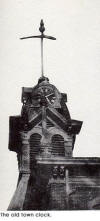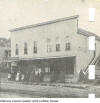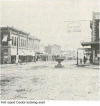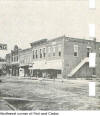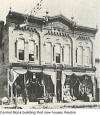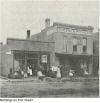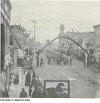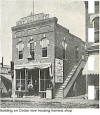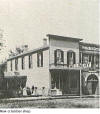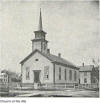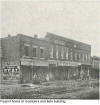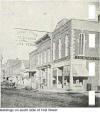 Early in the morning, the new fall sun up but a short time, clouds of dust could be seen rising along country roads as horse drawn family vehicles from surrounding farms and neighboring towns began the exciting trek to Monticello and the Great Jones County Fair. Lone horsemen, buckboards, and lumbering two and four-horse wagons overflowing with family, kinfolk, baskets of chicken, mountains of pie—all were headed for the pleasure and excitement that brought a glorious climax to the end of summer and harvest.
Early in the morning, the new fall sun up but a short time, clouds of dust could be seen rising along country roads as horse drawn family vehicles from surrounding farms and neighboring towns began the exciting trek to Monticello and the Great Jones County Fair. Lone horsemen, buckboards, and lumbering two and four-horse wagons overflowing with family, kinfolk, baskets of chicken, mountains of pie—all were headed for the pleasure and excitement that brought a glorious climax to the end of summer and harvest.
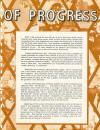
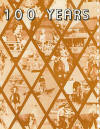 Tuesday had been Entry Day. Perspiring farmers had driven, prodded and vocally persuaded the pride of their livestock to security in the Fair pens. The ladies of Jones County and the nearby territory had breathed nervously 'til the last carefully wrapped Battenburg doily and the last embroidered underwear set were carefully encased on display. The hand painted jardinière was placed intact in Floral Hall. The multitudinous jars of piccalilli, butters and preserves waited, glistening, in competition.
Tuesday had been Entry Day. Perspiring farmers had driven, prodded and vocally persuaded the pride of their livestock to security in the Fair pens. The ladies of Jones County and the nearby territory had breathed nervously 'til the last carefully wrapped Battenburg doily and the last embroidered underwear set were carefully encased on display. The hand painted jardinière was placed intact in Floral Hall. The multitudinous jars of piccalilli, butters and preserves waited, glistening, in competition.
Wednesday the contestants' efforts had been judged. Now it was Thursday and, in best clothes and gay spirits, they viewed the results and relaxed with their neighbors. Plans had been made to meet seldom seen friends in shady Picnic Grove at the north end of the grounds. A familiar table-cloth-covered basket marked the place for the clan to gather, and reserved the spot though the picnickers were elsewhere.
The year with changes here and there could be any of the hundred between 1853 and 1953. The picnickers . . . any family in Eastern Iowa. The wheels of progress have turned, the horse is no longer a means of transportation, fashions have changed, and the Fair programs and facilities have kept pace with the changing times. Now, a century after that first meeting, "see you at the Monti Fair" remains a byword. Sure as autumn rolls around, families and food baskets arrive by the carload. Competition for premiums runs strong and youngsters, who have saved money for weeks, wander wide-eyed, entranced by the sights and smells found only at the county fair.
Beginnings of this century old institution are almost as dim as the year in which it was organized. The only thing recorded about its first meeting is that it was held on Bowen's Prairie midway between Monticello and Cascade in 1853. Enterprising residents of the county decided there should be an annual event as a fitting climax to the struggles and accomplishments of each year's work. They planned a county-wide picnic for a day of relaxation and pleasure, which would also give them a chance to display, study and compare the fruits of farming in all phases.
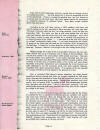 From such humble beginnings evolved a county fair of national renown a hundred years later . . . the first county fair in Iowa to successfully live out its First Centennial. History is clouded by passing time, and few records or memories exist of such early days, other than casual mention by newspapers or occasional reference in yellowed letters. Even these written accounts differ from each other.
From such humble beginnings evolved a county fair of national renown a hundred years later . . . the first county fair in Iowa to successfully live out its First Centennial. History is clouded by passing time, and few records or memories exist of such early days, other than casual mention by newspapers or occasional reference in yellowed letters. Even these written accounts differ from each other.
According to one such letter written in 1875 recalling "old times" the second meeting of the fair was held in Rome township, on a site near Olin. "The most I remember about the fair," the writer asserted, "is that the date was September, 1854. The region was then a wild waste dotted here and there with small hamlets, and the results of the fair were not dazzling." But it must have been a success in some way, at least, for it reached such proportions as to disturb the quite of the village. ". . . I was quite ill at the time and confined to my bed," continued the letter writer. "I was much annoyed by the number of guests at our house and still more by the unearthly noises accompanying the festivities. It lasted two or three days, but at last came to an end, to my great joy. However, I believe it was thought at the time worthy of the county."
Worthy enough, for in spite of the correspondent's bitterness, the next year, 1855, the Fair was set up in Anamosa, then a village of thirty buildings. This was the first exhibit in the county about which records were kept. Practically all of the exhibits were agricultural. A few stakes connected with rope near the site of the present Iowa Mens Reformatory held the livestock exhibits, which consisted of several cows of common breed, a few horses and some sheep. Household and garden departments were represented by a few blankets and quilts displayed in the old courthouse along with some sorghum molasses, vegetables and a dozen Iowa grown apples. A newspaper of the day reported an average attendance of forty people on the grounds at a time.
After a successful 1856 Bowen's Prairie exhibition, the Jones County Agricultural Society evidently took heart, for it again scheduled the 1857 meeting at Anamosa and awarded to James Peet the magnificent premium of $10 for the best cultivated farm in the county. Though other premiums were much smaller, they still totaled $197, so receipts of $43 from memberships and $97 from donations fell quite short. "This," a newspaper predicted, "will only create further dissension and rivalry between the county seat and the neighboring village to the north."
However, the Fair had come to stay, and steps were taken by the Society to establish the fair on permanent exhibition grounds, complete with graded race track, near Anamosa. Here, the Society felt, was the place to build a real county fair, with all the trimmings. Their optimism was well founded, for advances were evidenced in all departments. "Tom Hyer," a race horse from Cedar Rapids was on the grounds, and caused considerable excitement, for few people at that time had ever seen a real race horse. Yet before many years racing was one of the major events of the county fair. Agricultural exhibits were still the mainstay of the 1863 fair. J. A. Penniman won $5 for the best yoke of oxen; C. T. Lampson won $5 for the best trotting horse and J. M. Peet's farm was again awarded $5 as the best farm. Finances of the Fair made advances, too. Premiums paid and contingent expenses amounted to $420.90. Receipts from memberships were $221, which together with state aid of $200, left a balance of 10 cents on hand.
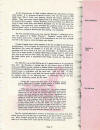 At the Anamosa fair of 1865, exhibits reflected the self-reliance of these early settlers. R. A. Rynerson of Bowen's Prairie, who was the owner of 800 apple trees, 300 of which were bearing, showed the largest assortment of apples. There were many cheese displays and S. G. Whitney earned an award for seven kinds of grapes. William Brazelton of Bowen's Prairie won $2 for his entry of home made cloth, and William Benadom won for the best straw hat specimen. Two premiums were awarded the puzzling entries of "54 fine Vermont Bucks" and J. A. Palmer's Artificial Mice. Perhaps early Jones County Fair exhibitors wanted to demonstrate that nothing was impossible.
At the Anamosa fair of 1865, exhibits reflected the self-reliance of these early settlers. R. A. Rynerson of Bowen's Prairie, who was the owner of 800 apple trees, 300 of which were bearing, showed the largest assortment of apples. There were many cheese displays and S. G. Whitney earned an award for seven kinds of grapes. William Brazelton of Bowen's Prairie won $2 for his entry of home made cloth, and William Benadom won for the best straw hat specimen. Two premiums were awarded the puzzling entries of "54 fine Vermont Bucks" and J. A. Palmer's Artificial Mice. Perhaps early Jones County Fair exhibitors wanted to demonstrate that nothing was impossible.
The first recorded racing purse was won by "Buckskin," a Dubuque horse who ran against C. E. Wales' "Peavine." "Buckskin" earned $100 for its owner with a 2:44½ time. In spite of the distraction of the Civil War, $149.50 was left in the treasury, when the books were closed.
President Joseph Tryon called attention to the fair of 1866 by the following announcement: "To the Citizens of Jones County and Vicinity: Recollecting our Agricultural Fair comes off October 3, 4 and 5th, we hope the examining committee will be on hand at 9 a.m., the second day. Dr. Blakeslee will be there with a large number of Chester White hogs and pigs and it is well worth your time to go and see them. (Well, the doctor is some on hogs.) Fowler of the Fisher House gives a magnificent ball Friday evening for the lovers of Dancing."
The 1866 fair was as Josh Billings put it "a great success as an agricultural hoss trot." On Thursday a trotting race for the County Purse of $100 first money and $50 for second, resulted in Charles Wales' Peavine so out-distancing G. S. Eastman's Lightfoot and H. Lamson's horse Lamson that it won both first and second money in accordance with the track rules. Time was 2:52. To allay dissatisfaction Mr. Wales turned back the second money to be used as a purse for another match on the following day. A newspaper item of the day recorded the excitement created by this event.
"Friday the second match took place. F. F. Beardsley entered Johnny Shoemaker, H. Lamson entered Lamson, L. Tisdale entered Iron Duke and G. S. Eastman entered Lightfoot.
"After some time spent in scoring, "Go" was called, Lightfoot taking her place to the rear on starting by agreement as her owner entered her in the match for training rather than with idea of success, she being young and with little training. Shoemaker was favorite and backed pretty heavily particularly by Dubuquers, a number of whom had come out to 'absorb' country green backs and teach their rural neighbors how to do it and how not to do it. Johnny was a Dubuque hoss. They knew the hoss. Seven went to their bottom dollar on him but Johnny was evidently not in sympathy with them and went back on them to the tune of a cool thousand, and behaved badly and Iron Duke won the heat in three minutes with Lamson close on his flank. Second and third heats were contested with great spirit by Lamson and Iron Duke."
The Fair seemed destined to continue at Anamosa, but interest had diminished during the Civil War and it continued to go down hill for years following. Rainy weather plagued fair week annually, until in 1873, what records refer to as "the tidal wave" came and the meeting was not held at all.

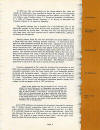 In 1874 new life was breathed into the almost defunct fair, when the articles of incorporation were amended to change the name of the sponsoring body to the Jones County Fair Association, and new officers were elected. The new officers were: President, Major S. S. Farwell of Monticello; Vice-President, E. V. Miller of Viroqua (Morley); Secretary, C. W. Gurney of Monticello and Treasurer, Captain A. M. Loomis of Wyoming.
In 1874 new life was breathed into the almost defunct fair, when the articles of incorporation were amended to change the name of the sponsoring body to the Jones County Fair Association, and new officers were elected. The new officers were: President, Major S. S. Farwell of Monticello; Vice-President, E. V. Miller of Viroqua (Morley); Secretary, C. W. Gurney of Monticello and Treasurer, Captain A. M. Loomis of Wyoming.
The greatest change was in location, for it was held that year on the Monticello grounds of the Union Driving Park Association, later sold to the city of Monticello for its City Park. The forty acre tract was ideal for the fair with large trees, wide level expanses and a natural amphitheatre, adding to the beauty of the grounds.
Starting without funds the new Fair Association borrowed $1800 to erect a Floral Hall and other buildings deemed necessary. A solid board fence eight feet high completely enclosed the forty acres. Spectators were seated in the natural amphitheatre, south of the one now in use, where the natural slope curves around the track. Ball games were played at this southern end of the track infield, but the batter and diamond faced north, rather than east as at present. Fair activities centered about the Floral Hall, which at that time was a large round structure with wings in each direction of the compass. One wing for many years was used as a dining hall, and was run by one of the local churches. The roof of the hall was an open air pavilion, where band concerts were held and promenading, for a fee, took place. This afforded an excellent opportunity to see and be seen and impress 'the best girl friend'.
Anamosa reorganized a Fair under the Anamosa Fair Association so two Fairs were supported by the County with great rivalry. The Anamosa project eventually succumbed, while the Jones County Fair in its Monticello location continued with increasing success. However, the early years of the fair in Monticello were not easy, as rain poured down year after year promptly during fair week. Nevertheless County and Community pride in the Fair continued to increase and its cultural and educational importance became rapidly more evident, as this newspaper article of 1877 pointed out:
"Many of the people who will be attracted to our coming Fair visited the Great Centennial in Philadelphia and spent weeks in studying its varied attractions and its fine art and its beautiful display of nature's poetry - the flowers. All this has had but one effect, that of educating people up to great regard for more refinement and cultivation in man's appreciation. Unless this department in the Jones County Fair is well conducted, no matter how great a success others may be, nine tenths of the persons who visit the exhibition will be disappointed."
 At the 1879 exhibition the Anamosa Art Association showed 131 paintings! Mrs. P. McCarn showed twenty-three works, Mrs. C. A. Lee showed twenty-seven, and Miss Tirzah Holt, thirteen. Others exhibiting were Mrs. J. S. Stacy, C. E. Littlefield, Misses Lou and Olie Shaw and Mrs. Nellie Gawley. Music was also featured that year as a $100 premium was offered for the best band playing. This inspired a great interest in band music, and fair goers were found to enjoy the bands equally as much as the exhibits.
At the 1879 exhibition the Anamosa Art Association showed 131 paintings! Mrs. P. McCarn showed twenty-three works, Mrs. C. A. Lee showed twenty-seven, and Miss Tirzah Holt, thirteen. Others exhibiting were Mrs. J. S. Stacy, C. E. Littlefield, Misses Lou and Olie Shaw and Mrs. Nellie Gawley. Music was also featured that year as a $100 premium was offered for the best band playing. This inspired a great interest in band music, and fair goers were found to enjoy the bands equally as much as the exhibits.
 "Go to the Fair!" pleaded the local paper in 1881. "Go to the Fairbecause you want a week of respite from your farm, because you want to see your neighbor and compare notesthe best method of education; because you want to see the best horses, cattle, sheep and swine and compare their merits;because you desire to see fruits and flowers and products of art, these rich and helpful and beautiful results of our highest civilization and best culture.
"Go to the Fair!" pleaded the local paper in 1881. "Go to the Fairbecause you want a week of respite from your farm, because you want to see your neighbor and compare notesthe best method of education; because you want to see the best horses, cattle, sheep and swine and compare their merits;because you desire to see fruits and flowers and products of art, these rich and helpful and beautiful results of our highest civilization and best culture.
 "Go because you want your boys to rub up against the world and not get rubbed out; go because you want your girls to know better than to walk hand in hand with a greenhorn sucking a stick of candy and laughing like a squeeling colt and because you'd have them acquire tastes, ideas, and habits corresponding to intelligence and refinement of the age in which they live.
"Go because you want your boys to rub up against the world and not get rubbed out; go because you want your girls to know better than to walk hand in hand with a greenhorn sucking a stick of candy and laughing like a squeeling colt and because you'd have them acquire tastes, ideas, and habits corresponding to intelligence and refinement of the age in which they live.
"Go to compare yourself, your family and your products with your neighbors. After the comparison many an animal gets better care, many a farm looks neater, and a brighter touch comes to many a home also."
The public rose to the occasion. Mrs. James Davidson exhibited her collection of 225 house plants. (Fair visitors were also informed that she pursued church, Sunday school, and temperance work and debated literary and social questions besides caring for her home, family and houseplants.) J. W. Doxsee, editor of the local paper, cited a suit of lady's underclothing created by Mrs. S. R. Howard as probably the most elaborate piece on display. "The weakness of the sex for what is showy and fine in this class of drapery we could not understand," he wrote, "but it had fine illustration in the Floral Hall. But we can not particularize." It was felt that Floral Hall competition did much to nurture "that noblest flower grown on American soil - the rare and beautiful rose known as the American Woman." In support of these noble sentiments old timers recall a visitor from a nearby town who appeared in full dress suit, with boiled shirt, black bow tie and high silk hat. He had taken the outfit in on a horse trade and felt it proper costume for the Great Jones County Fair.
Although the Fair had acquired a great deal of polish and culture, amphitheater spectators, when seating themselves on the grass to watch the races, were ever alert to avoid the rinds from huge thirty cent watermelons sold on the grounds, a favorite dessert of fair picnickers.
"Everything is ready for the Fair!" proclaimed 1883 fair bills, and many improvements had been made under President C. E. Wales and Secretary G. Leighhardts direction; two thousand dollars had been spent for building improvements, artesian well water from city wells had been piped to the grounds and a sidewalk had been constructed from the depot to the fair-grounds. The sidewalk resulted from heated protests of the ladies over the condition of their skirts from tramping through the mud, dust and weeds along the way.
The interior of Floral Hall was bright with a new coat of whitewash. Fair goers of the day still recall removing their shoes after touring each wing to empty out the white sand which comprised the floor.
The horse races that year, for the first time, were run under National Association rules after criticism of jockeying and sportsmanship in 1882.
People were becoming more conscious of the time and effort required to produce their growing Fair. An editorial in the local paper expressed it as follows:
 "The fair this year will cost the President $200 out of his own pocket and the same is true for the Secretary, to say nothing of the neglect of their own business and the weeks of devotion to this institution which belongs not to them but to the people. So people can afford to overlook mistakes which may appear in view of all sacrifices of time and effort and money officers have made to insure success."
"The fair this year will cost the President $200 out of his own pocket and the same is true for the Secretary, to say nothing of the neglect of their own business and the weeks of devotion to this institution which belongs not to them but to the people. So people can afford to overlook mistakes which may appear in view of all sacrifices of time and effort and money officers have made to insure success."
Livestock entries were notable in 1884, with over a hundred head of swine in the pens. Exhibitors included E. V. Miller of Viroqua; Ezekiel Moore, Cascade; John L. Clark, Monticello and Lewis Starry, Olin. Cattle winners included A. C. Gleason of Delhi, George Lathrop and Henry George. H. Eilers took the Grand Sweepstakes premium of $100 for the best stable of horses.
 The Fair was becoming a greater and greater drawing card for Eastern Iowa. In 1884, Thursday, traditionally the 'big day' drew a record of five thousand people. Railway cars bringing people to the Fair from the north were insufficient, and many were forced to ride on coach tops and in cattle cars. This caused extensive protests to the railroad, and President Wales who took pride in the Fair and in Monticello as a railroad town in that day, felt that fair goers should not be "herded like animals."
The Fair was becoming a greater and greater drawing card for Eastern Iowa. In 1884, Thursday, traditionally the 'big day' drew a record of five thousand people. Railway cars bringing people to the Fair from the north were insufficient, and many were forced to ride on coach tops and in cattle cars. This caused extensive protests to the railroad, and President Wales who took pride in the Fair and in Monticello as a railroad town in that day, felt that fair goers should not be "herded like animals."
Two concessionaires were likewise becoming traditions. Most older Fair goers became nostalgic at the name of "Candy Bill" Leech. Candy Bill moved with the Fair, from Anamosa to Monticello in 1874. He fastened his taffy hook on a large maple tree, tacked white oil cloth on the tree and began making cream candythe first hot candy made on the grounds. He died in 1930 at Anamosa, but tradition is carried on by Cecil R. Farmer, whose familiar screen enclosed stand now replaces Candy Bill's tree hook and taffy covered table in virtually the same location. To many 'old timers' the Monti Fair's cream candy is still Candy Bill's. The other familiar concession man of the day was Major Noble Winner, a dwarf from Monticello who was as well known for his saucy conversation as for his hot buttered popcorn.
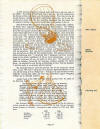 A third concession operator, became quite well known, too, one year in the 1880's. He vended cold root beer from a big vatthe first introduced at the fair as a drink, and many were the curious tasters. From time to time, he stirred the brew violently and froth would billow to the top. As he was dismantling his stand after the fair, onlookers discovered that the reason for the excessive frothing, was a sack of soap hidden in the bottom of the vat.
A third concession operator, became quite well known, too, one year in the 1880's. He vended cold root beer from a big vatthe first introduced at the fair as a drink, and many were the curious tasters. From time to time, he stirred the brew violently and froth would billow to the top. As he was dismantling his stand after the fair, onlookers discovered that the reason for the excessive frothing, was a sack of soap hidden in the bottom of the vat.
Fairs of the late '80's saw many memorable events. Manley Allen, celebrated Indian scout, appeared with his band of Sioux Indians. The thrilling spectacle known as the Grand Balloon Ascension was introduced, and became by far the most popular attraction for several years. It was guaranteed to make at least three ladies faint at each ascension. Hot air balloons, some ninety feet across, were used. A long trench was built with a fire at one end and a funnel at the other. The collapsed balloon was placed over the funnel, and small excited boys were allowed to hold the sides of the bag apart to help it fill more quickly. Many of the "oldsters" still recall the thrill of participating in this great event. As soon as the bag was completely filled with hot air, a parachute was hitched on and the performer, grandly called "The Aeronaut," seated himself on a trapeze attached to the parachute. When the daredevil reached the desired altitude he tripped a release and floated back to earth with the parachute. Such men (and occasionally women) were respected for their daring feat, and they felt their position keenly. One aeronaut interviewed before performing said, "I instinctively feel it dangerous and there naturally comes to my mind a recollection of all my moral shortcomings. I try to do right, but I presume all men are guilty of some sins." This performer was billed as Monsieur Trencaville for ascension watchers prefered the French flavor. He admitted his real identity as Dockstader of New York but declared, "I yield the palm to no aeronaut alive for daring."
The Monticello Express stated the general view of the county Fair crowd when it said, "We have a liking for the customary dignified balloonist in his new silk hat sitting as if in a Palace Car." And thus was reprimanded a livelier balloonist wearing blue tights and skull cap, disdainfully tagged "Wriggling William" by an offended audience.
Another facet of the 1888 Fair drew critical comment from the editor of the Wyoming Journal:
"While eating in the church dining hall run by the Monticello Congregational Society on the Jones County Fair Grounds last Thursday, we prayed that Mrs. Cleveland might succeed in her laudable enterprise of abolishing the bustle. The dining room was large and so was the crowd of hungry people which thronged it.
"Aisles left for lady waiters between the long tables were exceedingly narrow; our chair back was of usual height, but not high enough to protect our back and shoulders from the double-duplex, back-acting, wire-woven, steel ribbed and immense proportioned bustles that rolled, thrashed, scraped, rushed and ploughed across our back as waiters flew back and forth across the aisle."
Fair president Sherman and Secretary Henry showed nothing but pleasure as they reported the most financially successful Fair yet held with ten thousand persons present on Thursday. Comparative gate receipts for 1887 and 1888 were:
| |
1887 |
1888 |
Tuesday |
$49.90 |
$147.15 |
Wednesday |
302.87 |
486.70 |
Thursday |
1,411.35 |
1,777.55 |
Friday |
416.94 |
536.55 |
Gate receipts together with other income totaled $4,520.05 and an additional $200 was added later from the State Treasury. This gave an estimated surplus of $600 to $800. President Sherman, Secretary Henry and the rest of the board were re-elected for the next four years.
 Baseball fans got a new thrill about 1889 when H. M. Carpenter, Sr., well known Monticello banker, introduced the catcher's mask to the baseball fans at the Great Jones County Fair. A Dyersville sportsman of the time recalled years later, "Back in my baseball days, forty years ago they used to take the ball on the first bounce, fifteen feet back of the batter. Never knew such a thing as a mask and boys took 'em in the bare hands like John L. and Jack Killian used to fight. This man Carpenter, he was considered the best ball catcher in these diggin's and "H. M.", when the new-fangled face protector was invented, had the first one anyone had seen here-about.
Baseball fans got a new thrill about 1889 when H. M. Carpenter, Sr., well known Monticello banker, introduced the catcher's mask to the baseball fans at the Great Jones County Fair. A Dyersville sportsman of the time recalled years later, "Back in my baseball days, forty years ago they used to take the ball on the first bounce, fifteen feet back of the batter. Never knew such a thing as a mask and boys took 'em in the bare hands like John L. and Jack Killian used to fight. This man Carpenter, he was considered the best ball catcher in these diggin's and "H. M.", when the new-fangled face protector was invented, had the first one anyone had seen here-about.
"Well, when his team played at the Fair the first year with 'the catcher with the silver mask' as they called him, people flocked from all over to see him. It was quite a sensation to have a man stand in the shadow of the batter and take the ball off the bat as they said.
"But long with it there was a lot of razzing by opposing fans who called it a rat trap, calf muzzle and I guess the veteran banker can still recall some names for it. Crowds came from great distances to Monticello to see the ball games and I rode horseback down from the settlement to Monticello to see the catcher in action."
Adequate excursion trains were now bringing hundreds of visitors to the Fair Wednesday and Thursday. A train from the north left Fayette at 7:45 a.m., touched Brush Creek, Strawberry Point, Edgewood, Greeley, Delaware, Delhi and Hopkinton and finally arrived overflowing with passengers, and picnic baskets, in Monticello at 10:20 a.m. A train from the south out of Oxford Junction made connections with all east and west trains. Trains from Cedar Rapids and Farley also brought many Fair goers taking advantage of the special one and one-third round trip fares. Arriving trains were usually met with gala fanfare, supplied by bands playing in the bunting-decked depot park near the mermaid encrusted fountain. The jaunt to the Fair Grounds was made on foot (it was advertised as a five minute walk) or sometimes in one of the horse drawn hacks or buses which made breakneck dashes for the grounds, as the faster they went the more fares they could carry.
Big livery firms like Connor and Hogan changed horses near the corner now occupied by Sacred Heart Catholic church. One team made the dash to the depot, loaded up and flew back to the corner where another team took over for the flight to the Fairgrounds. This was really a remarkable feat, and in dry weather residents on Sycamore Street reported dust made visibility impossible, while in rainy weather mud made the impossible impassable.
In 1889 good weather prevailed and over three thousand people picnicked in the Grove and under the shade trees. The importance of the horse in those days was brought out by the horse show that year. There were large classes of roadsters, draft breeds, general work horses, Percherons, Percheron-Normans and Clydesdales. Special attention was also given a herd of Black Aberdeen Angus owned by W. S. Niles of Wyoming. It was, evidently an unfamiliar breed in this locality for the local newspaper predicted, "These glossy, hornless cattle will rapidly gain in favor."
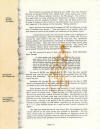 Great interest was aroused the following year, 1890, when Fair President Sherman announced, "Parties from abroad have written saying they will be at the Fair with Edison's greatest invention, the Phonograph. This will be a rare opportunity for those watching new discoveries in science to familiarize themselves with this wonderful machine." Many were the dimes paid for the privilege of sticking a tube in each ear and listening for a few minutes to whatever happened to be playing on the marvelous "Talking Machine."
Great interest was aroused the following year, 1890, when Fair President Sherman announced, "Parties from abroad have written saying they will be at the Fair with Edison's greatest invention, the Phonograph. This will be a rare opportunity for those watching new discoveries in science to familiarize themselves with this wonderful machine." Many were the dimes paid for the privilege of sticking a tube in each ear and listening for a few minutes to whatever happened to be playing on the marvelous "Talking Machine."
Robert Ryerson also keynoted the progress of 1890 by displaying a large herd of antelope from Kansas - "Your last chance to see animals which will soon become as extinct as the buffalo with settlement of the Western Plains".
Among the thousands who viewed such wonders was a delegation of 150 people from Dubuque, under the leadership of C. E. Wales who was now running the Julien Hotel in that city. For the most part, they represented Dubuque jobbers and manufacturers, who hoped to "strengthen commercial ties heretofore existing." They were met at the depot by the Ladies Cornet Band of Monticello and the Monticello Business Men's Association. They joined with the Dubuque Military Band, which had accompanied the delegation, for a grand parade through the flag decorated business district.
The Fair continued to grow in favor and importance. Wrote Monticello's Editor Doxsee:
"In good weather and amid showers and passing rain, in sunshine and in storm, the fair has been held each year developing some excellence over ones preceeding. The little saplings then set out here became beautiful shade trees furnishing shade and shelter for all on the grounds. The young men and maidens who in early years of the fair did their courting on the fair grounds are now middle aged and married people and they will not fail to take their children to the beautiful spot where they loved wisely and well."
The sum of $3,100 was appropriated in 1891, from the town council's general fund, and the forty acre fairgrounds was purchased from the Union Driving Park Association. The land was to be used for park purposes the rest of the year.
September 5th through 9th were the dates chosen for the Fair in 1892, which in commemoration of the 400th anniversary of the discovery of America was billed as the Jones County Columbian Exposition.
Since bicycles were still a novelty and therefore of much interest to fair crowds at the time, the fair association, anxious to please its patrons, offered $50 in prizes for bicycle races. Prizes consisted of a $20 free-for-all, a $15 Jones County purse and a special $15 prize for ladies. Most bicycles were the huge front wheel, tiny back wheel type, and to pilot one of these around the half-mile dirt track meant that the gasping, beet-red winners certainly earned their rewards. Catering to the dignity of the Fair patrons that year were tents erected by Lenox College, the Old Settlers' Association of the county, and the W. C. T. U. which checked parcels for a small fee and "heartily welcomed all callers."
The 1892 Fair Board likewise let it be known that, "No gambling or fakirs will be allowed on the Jones County Fair grounds at Monticello. The fair, which always pays its premiums in full, depends on legitimate means for support and is always successful, where as, some of the neighboring fairs which reach for the dimes of the gamblers, lose the dollars of disgusted patrons."
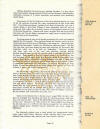 Officers elected for the ensuing year included: President, T. A. King, Monticello; Vice President, George Lathrop, Oxford Junction; Secretary, William Stuhler, Monticello; Treasurer, R. P. Smith, Monticello; and Marshall, Alex Sutherland, Scotch Grove.
Officers elected for the ensuing year included: President, T. A. King, Monticello; Vice President, George Lathrop, Oxford Junction; Secretary, William Stuhler, Monticello; Treasurer, R. P. Smith, Monticello; and Marshall, Alex Sutherland, Scotch Grove.
Encampment of the First Regiment of the Iowa National Guard, just north of the fair grounds, all during fair week, overshadowed all else at the 1894 Fair. Six hundred guardsmen, including Ervin Reed of Monticello, who was a student officer at Iowa State College in Ames, descended upon the town to camp and drill, under the awe-struck scrutiny of the largest crowds yet seen at the Jones County Fair. Artesian well water was piped over the entire area of the camp and Young's Bakery contracted to supply seven hundred loaves of bread a day to the encampment.
The troops came by train on the Sunday preceeding Fair week and unloaded opposite the fair grounds. They marched through the northern section of town, which was known at that time as Oklahoma, to the camp site. "Major Springer, reported the local paper, "made every Oklahoman salute the colors." The first few days they were busy setting up camp and preparing for Governor's Day inspection, which was to be held on Wednesday. Governor Jackson and party were met at the train and gloriously escorted through bunting arrayed streets to the fair grounds amid a seventeen gun salute in his honor. Dress parade of the six hundred soldiers was reviewed by him and thousands of fair goers, while five thousand rounds of ammunition were fired in sham battle. Afterward a Grand Reception was held in Floral Hall, at which the Governor and guard officers shook hands with everyone. "There is something, summarized the local paper, "in military movements of large bodies of men, the uniforms, and waving plums that inspires one with the majesty of power and force of government."
But the novelty was wearing off, both for soldiers and citizenry. Comments in the little "Daily Fair News" ran "Don't josh the guards anymore . . . Who picked Bajasch's chickens and milked the cows on the north flats? . . . There seems to be a tough element in the military crowd . . . Profanity and revolver fire alarmed the residential districts Thursday night . . . Our women are insulted on the streets . . . They hunted strays (guardsmen) through the alley and coal cellars Friday." The troops enlivened their departure by firing blanks from the train windows at nervous citizens. The following week the local paper summed up the general feeling when it stated "The streets of Monticello are not quite so lively as they were while the soldiers were here. But the chickens and watermelons are safer now."
"Come to the Greatest Fair in Eastern Iowa," urged 1896 fair bills, "and don't be inveigled into attending any other by alluring promises which you know will never be kept. Come to the Old Reliable Jones County Fair, the Peer of them all." Keeping it the "Peer of them all" meant adding new things to the old each year, so in 1896 the Fair Board arranged for "an exhibit of the popular college game, Football, between Monticello and Lenox College of Hopkinton"
The Monticello athletes were a hand picked, but inexperienced eleven whose roster listed Prader, Hollenaur, Smith, Cassady, Rohn, King, Sweesy, Podhaski, Sam Johnson, John Johnson and Team Captain, Gardner.
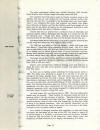 The cocky, experienced college team included Thompson, Mills, Dewald, Russel, Hopkins, Main, Dunlap, Joseph, McCready, French and Wolf.
The cocky, experienced college team included Thompson, Mills, Dewald, Russel, Hopkins, Main, Dunlap, Joseph, McCready, French and Wolf.
Fair spectators found the game rough and keenly contested, however the Athletics had been so well coached by the towering Johnson brothers that they kept the score 0-0. Local pride in the Monticello team went even higher, when it was whispered that Lenox had imported two players from Upper Iowa University at Fayette, and that the Athletics could have bought off two Lenox men the day before the game, but the management preferred to meet honest defeat rather than glory in dishonest victory.
Interest had been so spirited that a combined team of Monticello and Anamosa pigskin pushers challenged Sand Springs to a contest for the Fair the following year. Though Sam Greer, suffered severe facial fractures carrying the ball for Sand Springs, they beat the Southern County boys 6-4.
And Major Noble Winner appeared as usual with his popcorn stand and also a bride, thirty-five inches high, and weighing forty pounds.
The 1899 Fair was billed as "The Old Reliable - Better and Larger than Ever Before." Floral Hall entries surpassed all prior years. Mrs. D. E. Pond won on eight kinds of cake, Alex Rice took ribbons on nine art work entries, Mrs. G. H. George won on fifteen different types of artistic handwork, and Mrs. Bentley Clark captured thirty-three honors for garden produce and such entries as walnut catsup, lemon jelly, delicate cake and watermelon cake.
The Ladies' Cornet Band and the Boys' Cornet Band of Monticello provided music and the Monticello Ministerial association provided devotional services from 12:30 to 1:00 p.m. daily.
Patrons were reminded that additional hitching posts had been put in along the entire west side of the grounds so there was plenty of room to hitch their teams.
As there was no lighting system satisfactory for large outdoor areas in 1899, Fair dates were advanced to August 8, 9, 10 and 11 to take advantage of the longer daylight hours. Not until recent years has fair week been established as the last full week in August. Earlier fairs were held any time between mid-August and the last week in September. However the 1899 Fair was unusually early, and partially because of that, attendance was not good. Fair activities closed down about six o'clock in the evenings as shadows lengthened, and after dark entertainment for fair goers was furnished by theatrical companies, which were always engaged for nightly performances in the Opera House downtown, during Fair week.
An early August fair was likewise held in 1900. This time stifling heat settled upon the grounds. "Good weather for lemonade stands but hard on stand-up collars," ran the consensus of opinion. "Sensational Races between O. McCaffery's Automobile and Expert Bicyclists," together with many other special attractions, many of which were later engaged by the State Fair, failed to bring in the desired attendance. Heat was partially responsible, but the early dates of the Fair kept many farmers away who were busy in the fields, and had no time to prepare entries or attend.
Ever mindful of changing conditions and suggestions to make the County Fair better, the Fair Board set the dates of the 1901 Fair ahead to August 20 to 23 and elected A. L. Fairbanks, a prominent farmer of the County, President to represent fully the farmers of the community. Other officers were: Vice President, E. G. Hicks; Treasurer, H. A. L. Bagley; and Secretary, O. R. Ricker.
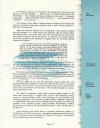 The 1901 Fair patrons were treated to "The Greatest Fair that Brains and Money can Devise including . . . Sweet Strains of Melody discoursed by big brass bands . . . Mrs. Murphy, only baboon balloonist in the world . . . A Midway Unequalled . . . Sights of Foreign Lands in profusion . . . and Mammoth Herds of Buffalo" - so ran the ads.
The 1901 Fair patrons were treated to "The Greatest Fair that Brains and Money can Devise including . . . Sweet Strains of Melody discoursed by big brass bands . . . Mrs. Murphy, only baboon balloonist in the world . . . A Midway Unequalled . . . Sights of Foreign Lands in profusion . . . and Mammoth Herds of Buffalo" - so ran the ads.
Mrs. Murphy nearly failed to appear after her balloon burned during one ascension but local seamstresses worked all day to finish making another, in time for her Thursday act.
Sports fans had the opportunity of watching the much idolized baseball star and manager, A. C. "Cap" Anson, who had been with the Chicago White Stockings for years. During the entire Fair week the forty-five year old, retired first baseman umpired all the ball games. In regard to the varied interests of the Fair spectators and exhibitors, a clipping from the Monticello Express commented as follows:
"The original purpose was to stimulate agriculture efforts by showing the best and courting rivalry in competition for premiums offered. In late years, however, the public demands more. Many there are without a direct interest in farming operations who ask for amusement. The result is a yearly presentation of free special attractions of the amusement order. We are not so sure but the farmers themselves leave the cattle shed and pig sty to watch the woman in red tights roll a ball to the sky or to observe other circus-like features not seen on the farm every day. At any rate, the County Fairs are More Cosmopolitan."
One feature which made the Monticello park so ideal for the annual exposition, was the beautiful grassy natural amphitheatre. Here spectators sat on quilts or blankets to watch racing and attractions and often wandered from group to group to visit with friends, who they saw only at Fair time.
Crowds kept growing and attractions became more elaborate, and in 1902, a new amphitheatre was constructed, at a cost of four thousand dollars and the track was graded. Many spectators felt that this limited the old time sociability, but they agreed that it was a necessary step.
The year 1902 also saw the Fair Association newly incorporated, with nearly three thousand dollars of stock sold. The Fair had been so successful financially, that all debts were retired, premiums fully paid, and dividends given to the stockholders for several years. They decided to build for a better, more comprehensive Fair.
The middle of September, 1903, found the Great Golden Jubilee of the Great Jones County Fair in progress with a bill of free attractions costing twenty six hundred dollars, which were advertised as "A stupendous and marvelous aggregation of renowned, wander-working, celebrities comprising an unchallenged, phenomenal, free attraction array consisting of Aerial and Acrobatic Twins, Mystifying Feats, Laugh Provoking Knock-abouts, Thrilling Sensational Acts, Pleasing and Entertaining DiversitiesNot A Single Filler in the Big List!"
Local merchants took special pride in arranging commercial displays in Floral Hall on this fiftieth anniversary. Among those making special observances were J. E. Bateman, Eilers and Bolton, W. F. Rohn, D. E. Pond, C. H. Schipman, The Lovell House and Owl Lunch Room.
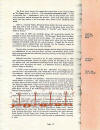 The Great Jones County Fair started the second half of the century billed as "The Biggest Event in All Iowa THE MAMMOTH MONTICELLO FAIR." It was a mammoth Fair Amphitheatre seats were sold out long before fair week and tremendous crowds thronged the grounds. Horse and cattle shows were prime, but hog cholera in the area kept many farmers from exhibiting their swine.
The Great Jones County Fair started the second half of the century billed as "The Biggest Event in All Iowa THE MAMMOTH MONTICELLO FAIR." It was a mammoth Fair Amphitheatre seats were sold out long before fair week and tremendous crowds thronged the grounds. Horse and cattle shows were prime, but hog cholera in the area kept many farmers from exhibiting their swine.
Qeen L., a Spring Valley, Minnesota horse, broke the track record for the 2:35 pace with a time of 2:15. Night shows at the opera house were likewise breaking records with performances of "Camille" and "Secrets of the Police of Russia."
Fair week of 1909 was decidedly damp, still excursionists braved the elements to arrive from north and south. The Davenport Band which had been hired for the Fair, met each train at the depot. The crowds were so great, that the band was pushed back into the depot park, where the iron fountain bubbled and frothed, aided by the natural showers. Pressed by the crowds, a trombone player stepped back and tumbled into the fountain, where he continued to blow from among the iron mermaids.
Though damp weather lowered gate receipts, the Fair board announced that no indebtedness of any kind had been incurred, and Secretary Koop would begin paying premiums the following Saturday morning at the store of Messrs. Hicks and Guyan.
Railroad excursions continued to be of great importance and in 1910 over thirty-one passenger coaches of people arrived for Thursday at the Fair. The famous and well remembered 53rd Regimental Band from Cedar Rapids provided music throughout the week. J. E. Bateman served as President and Fred W. Koop as Secretary.
In 1915, a new era began at the Fair. Electroliers were placed on the grounds and in the amphitreatre, and a Night Fair with a special Night Carnival was featured. Patrons were advised that gasoline lanterns would be in constant readiness if the electric lights failed.
Exhibits in Floral Hall were abundant. Miss Elaine Reed received more than twenty dollars in premiums. Mrs. George Guyan won on numerous specimens of Fancy Work and Eliza Zeadow had a list of premiums in the Jams, Jellies and Preserves department, which was described by the newspaper as "as long as a plumber's bill." Junior department competition became scrambled and Clark Byam won first in the Coffee Cake division and Vera Alcorn swept the Manual Training division.
Under President C. P. Rockstad and Secretary E. G. Hicks the Fair and Night Carnival, as it was advertised, continued to grow in spite of war clouds.
Floral Hall entries were present in enthusiastic numbers. Mrs. Henry George of Monticello had nineteen winning entries of hand painted china and Huberta Livingston of Hopkinton displayed more than fifty varied exhibits, ranging from art and fancy work to baked goods and miscellaneous items, such as "Menu for Threshers" (25 cent prize) and a collection of Kodak views. Morale was heightened by music from Professor Otto's Band, which gave concerts every morning downtown and on the grounds preceeding the night carnival. Frank Royden's Scotch Grove boys' band, also entertained "They are able to reproduce unusually difficult music with the ease of professionals," reported a critic.
The town and grounds for 1917 were patriotically decorated, with the French Tri-color much in evidence. A large Red Cross exhibit was prominent, while the Fair in general, seemed quieter with the gravity of world events.
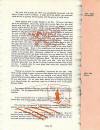 World progress had wrought changes in the Fair. The horse was losing out to the automobile. Horse show prizes were won by Peter Kurt, John Kurt, George Buol, Peter Bell, and Arnold Egger but "quality, not quantity" was the phrase used to describe the show. On the contrary, newspaper announcements advised, "The automobiles are so numerous now that those who sit at the wheel should not only drive slow but overly cautious. Kindly inquire of policemen for park spacing." The Fair of 1918, held August 20 to 23, reflected the pressure of World War on the home front. Patriotic observances were held and much emphasis was put on food conservation with canning methods and wheat-less and sugar-less meals being demonstrated every day. "Candy Bill, the old veteran who caters to the sweet tooth of childhood, is there in spite of the sugar shortage and he is selling real taffy," ran a local news item. "Major Noble Winner sticks to fresh buttered popcorn and laughs at the stand fellows worrying about sugar. Boxes in the amphitheatre had been rebuilt on concrete piers and the stalls divided into compartments large enough for four chairs, similar to the present plan. Occupants watched Dr. A. M. Maurice, widely known Monticello dentist and horse enthusiast, serve as starter for races with Ray George as judge and Fred Fagan as clerk. Headlining the fair was Roy D. Smith's famed Royal Scotch Highlanders Band. "The Best music is none too good for the Jones County Fair." fair goers were told. "This year the fair association goes clear 'over the top' in giving its patrons the best music money can buy. It spends more for music alone than many fairs spend for their entire line of attractions."
World progress had wrought changes in the Fair. The horse was losing out to the automobile. Horse show prizes were won by Peter Kurt, John Kurt, George Buol, Peter Bell, and Arnold Egger but "quality, not quantity" was the phrase used to describe the show. On the contrary, newspaper announcements advised, "The automobiles are so numerous now that those who sit at the wheel should not only drive slow but overly cautious. Kindly inquire of policemen for park spacing." The Fair of 1918, held August 20 to 23, reflected the pressure of World War on the home front. Patriotic observances were held and much emphasis was put on food conservation with canning methods and wheat-less and sugar-less meals being demonstrated every day. "Candy Bill, the old veteran who caters to the sweet tooth of childhood, is there in spite of the sugar shortage and he is selling real taffy," ran a local news item. "Major Noble Winner sticks to fresh buttered popcorn and laughs at the stand fellows worrying about sugar. Boxes in the amphitheatre had been rebuilt on concrete piers and the stalls divided into compartments large enough for four chairs, similar to the present plan. Occupants watched Dr. A. M. Maurice, widely known Monticello dentist and horse enthusiast, serve as starter for races with Ray George as judge and Fred Fagan as clerk. Headlining the fair was Roy D. Smith's famed Royal Scotch Highlanders Band. "The Best music is none too good for the Jones County Fair." fair goers were told. "This year the fair association goes clear 'over the top' in giving its patrons the best music money can buy. It spends more for music alone than many fairs spend for their entire line of attractions."
"Parking on grounds for automobiles," announced the fair bills. With 1919 and the coming of peace, aeronauts of the heavier than air variety became very popular at fairs. The earliest was reported to be Jimmy Ward, who received fifteen hundred dollars a day for two flights to Cascade and back in his one man plane. For ten cents each, daring and air-minded individuals were allowed inside the restraining ropes for a close-up view of the plane between flights.
Then came a Lieutenant Obernaur, stunt flyer, in a new Curtis two passenger bi-plane. The fair board sold ten rides to those wishing to try this unusual sensation.
A new swine pavilion was in evidence this year, built of hollow tile, with cement floor and running water. There were 127 hog entries.
Free attraction entertainment of the Night Fair included fireworks, band concerts, vaudeville and a showing of Charlie Chaplin's movie "Shoulder Arms."
Fair week 1920 was, for once, a complete week of sunshine. Over ten thousand people crowded the grounds on Thursday, and automobiles were so numerous that late comers were forced to drive clear to the east side of the race track and park opposite the amphitheatre.
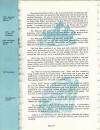 Dyersville played Ryan Friday in the two hundred dollar baseball play-off. Pitching for Dyersville was Koop who had pitched and won the game the preceeding Wednesday. He was winning 8-6 until the last of the ninth when he finally tired and Ryan pushed three more runs across without getting a man out. On Friday night, Gilbert and Sullivans' "H. M. S. Pinafore" was performed, on a specially constructed seventy foot stage, by a cast of over two hundred local people. In principle rolls were T. S. Lazell, Mrs. C. G. Thomas, Mrs. F. J. Kay, Mrs. Harry Lang, Vincent Balcar, John Liddy, O. B Crane and Eugene DeWitt.
Dyersville played Ryan Friday in the two hundred dollar baseball play-off. Pitching for Dyersville was Koop who had pitched and won the game the preceeding Wednesday. He was winning 8-6 until the last of the ninth when he finally tired and Ryan pushed three more runs across without getting a man out. On Friday night, Gilbert and Sullivans' "H. M. S. Pinafore" was performed, on a specially constructed seventy foot stage, by a cast of over two hundred local people. In principle rolls were T. S. Lazell, Mrs. C. G. Thomas, Mrs. F. J. Kay, Mrs. Harry Lang, Vincent Balcar, John Liddy, O. B Crane and Eugene DeWitt.
The following year more than five thousand dollars was offered in premiums. Mary Locher and Ted Koop, 1953 President of the National Press Club in Washington D. C., served as assistant secretaries in Floral Hall.
The 1926 Fair was filled with the gaity of the '20's. J. Leroy Farmer organized a booster trip, with fifty cars and a band, Masqueraders and other entertainers, to inform neighboring towns about the Charleston Contest, Ford Relay and other amateur competition.
The Ford Relay consisted of six heats and each contestant needed two Fords, minus self-starters, to enter. Instructions were to race one-half mile in the first car, get out, crank the other car, and complete the heat. How many finished the race and how many wrenched backs resulted is not on record.
After many years of discussion, the Fair Association decided in 1927 that the Fair should be held during the last full week in August from that time on. This proved popular immediately. Field work and harvest were nearly completed, children were still on school vacation, the most severe summer heat was over, and both town and farm people were ready for relaxation after the busy summer.
The 1927 Fair featured professional races. Horse race fans watched a string of derby horses run fourteen races. Also racing was a two year old saddle horse, which claimed the record of 59 seconds for the half-mile. New and exciting were dog races run by a pack of Whippets from Calgary, Canada. Their reported speed was 175 yards in 9 seconds.
Farmer Burns, famous wrestler, managed the Wolf Company's athletic shows on the Midway. Dr. J. W. Benadom's Fife and Drum Corp, assisted by his sons, and Charles Clark of Maquoketa and Frank Byerly of Anamosa, appeared that year and are still recalled by many. Benadom had trained a Robin, caught the previous spring, to sit quietly on his fife as he played. The two were a familiar sight on Monticello streets for several years.
Heavy rains and high winds got the 1928 Diamond Jubilee exposition off to a tempestuous start. Over a thousand dollars damage occurred as hail riddled and flattened tents.
The city made special efforts for the Fair's 75th birthday. A proclamation urged that merchants install appropriate window displays, that the city scrub the paving like a "Dutch Kitchen," and that private citizens start lawn mowers to "slick-up" the long grass in the corners.
Leola A., a mare belonging to Dr. Loes of Dubuque, celebrated the occasion by pacing the local track in 12:12¢, upsetting the 12:13¢ mark of many years standing.
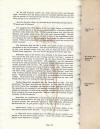 On the ball diamond another hot rivalry between Ryan and Cascade raged. Seventeen year old Kobza, pitcher for Cascade, allowed only five hits and one earned run, but Cascade lost 3-0 after making three errors in the first inning letting in two unearned runs.
On the ball diamond another hot rivalry between Ryan and Cascade raged. Seventeen year old Kobza, pitcher for Cascade, allowed only five hits and one earned run, but Cascade lost 3-0 after making three errors in the first inning letting in two unearned runs.
Music for the gala Jubilee was provided by the Monticello Municipal Band - "32 pieces and all talented."
Fire staggered the 1930 edition of the Fair, when flames of unexplained origin, suddenly glowed in the wooden amphitheatre on a Saturday afternoon, just three weeks before Fair time. Flames were so intense and rapid that the platform and judges stands across the track were charred badly. Kenneth "Gump" Ferring's car, standing on the track in front of the amphitheatre while he worked on the track for the approaching Fair, caught fire before it could be moved. Within twenty minutes only the concrete piers on which the structure had stood, remained.
The Association took the loss in stride, and quickly erected a temporary grandstand on the old foundation. Free acts presented that year were notable, as they changed nearly every day, and an eight girl chorus line, the Melody Maids, appeared. This was the first Gorgeous Girl review seen here.
Depression years of the Thirties were reflected in the Great Jones County Fair, just as the lush years of the "roaring twenties" had been. Instead of succumbing to lean days, as many Fairs did, the Jones County Fair adjusted, and rode out hard times successfully. One adjustment was the substitution of local stunts and personalities for expensive outside, professional attractions usually associated with the Fair. The racing program, for many years, consisted of farmers' amateur horse races and other novelty races. Good presentation made these very popular with Fair patrons. Politicians like Louis Murphy and Henry Field, opposing candidates for United States Senator, found Fair week audiences listened intently to speeches foretelling the road back to prosperity. Emphasis focused, as in early years, on agricultural and homemaking exhibits. Floral Hall entries increased more than twenty five per cent, even though other fairs were closing their halls for economy.
Another Depression adjustment was the "free gate" of 1932. Fair bills advertised, "The Great Jones County Free Fair!" In line with the Depression the Jones County Fair Association has decided to throw open the gates of the fair grounds on the occasion of the regularly scheduled fair and to make no charges for admission to the grounds except for automobile entrance charges to those wishing to drive onto the grounds. "However, there will be plenty of parking space outside the grounds."
Meanwhile, the amphitheatre at Anamosa had been destroyed and with this further discouragement, the long time rival Anamosa fair was abandoned. Anamosa business men generously decided to close Wednesday afternoon of the Monticello fair "to give greater support to the only fair left in the county."
"Hibred Corn" made an unusually interesting and timely display at the Farm Bureau project booth, that year. It was entirely new to many people.
In 1934 beef entries doubled those of 1933 and special emphasis was placed on the pure-bred livestock division. Floral Hall exhibits also increased despite severe Midwestern droughts.
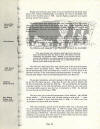 Though still seventeen years short of its own Centennial, the Great Jones County Fair entered wholeheartedly into helping the town of Monticello celebrate its first hundred years in 1936. Special displays, pageantry and square dancing marked the occasion.
Though still seventeen years short of its own Centennial, the Great Jones County Fair entered wholeheartedly into helping the town of Monticello celebrate its first hundred years in 1936. Special displays, pageantry and square dancing marked the occasion.
The largest baby beef exhibit yet seen here, consisted of fifty-five calves shown by thirty-three boys of the county that year. Victor Richardson had Grand Champion dairy calf in the Holstein division, Floyd Sievers showed the Grand Champion Guernsey and Maynard Kuhns showed the Grand Champion Brown Swiss.
Officers of the 1936 Fair were: President, L. E. Hoag; Vice President, H. W. Stuhler; Secretary, S. E. Locher; and Treasurer, H. M. Carpenter. Directors were: L. E. Hoag, Max Wortman, H W. Stuhler, J. C. McConaughy, J. J. Locher, T. J. George, H. M. Carpenter, Jr., Harry Rodman, M. F. Hogan and C. A. McLaughlin.
The following item appeared in the Centennial edition of the local paper:
"The Jones County Fair, officially rated high by the Iowa Fair Board, incorporated under the laws of Iowa, with status of private corporation, has excellent credit. Whether or not the fair returns a profit, the exhibitors are always assured of their cash premiums. One of the few fairs in the state which has no funded debt and one that has never failed to pay off in full."
The 1937 fair's baby beef show took special pride in the Grand Champion Shorthorn shown by George Fraser. After winning a first place and another Grand Championship at the Iowa State Fair, it went on to win first place in the Shorthorn division at the International Livestock Exposition at Chicago. It was the only blue ribbon winner at the International from Iowa that year.
The greatest attendance and cash receipts in thirty-four years were drawn by the Fair the following year. Mate Rice, 89 year old uncle of Charles and Ed Rice of Monticello, attended the 1938 Fair. He was thrilled by the bustling, successful venture, for he said he had been one of thirty-six men who gave a hundred dollars each to start the fair at Monticello in 1874. He believed he was the only one still living in 1938.
The next years saw continued improvements in Fair facilities. New $2,500 racing stables . . . 170 feet long with 16 stalls making a total of 43 . . . some of the best available in Iowa, had been built in 1938. In 1939 a new free act platform and band shell were erected.
With the tremendous growth of 4-H activities, there was a pressing need for more exhibit space in Floral Hall. In 1941 two large wings were added and a streamlined fa¢ade built on the south side, styled after exhibition buildings featured in World Fairs. The Fair Association could now claim that every building on the grounds had been built or re-built within the last five years, to accommodate the larger, more modern Fair.
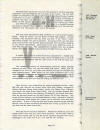 The Great Jones County Fair was more than proving its worth by providing competition and encouragement for the youth of the county. The 4-H stock parade was scheduled for Thursday night instead of Thursday afternoon, because it had grown so in size, importance and interest. 4-H activities had become so extensive that there was little room for commercial producers' competition. Friday of 1941 became the greatest single day in Jones County Fair history . . . over fifteen thousand people jammed the midway to a standstill, bearing out Governor George Wilson's assertion after his Thursday visit, that the Monticello Fair was "the greatest seen, next to Des Moines."
The Great Jones County Fair was more than proving its worth by providing competition and encouragement for the youth of the county. The 4-H stock parade was scheduled for Thursday night instead of Thursday afternoon, because it had grown so in size, importance and interest. 4-H activities had become so extensive that there was little room for commercial producers' competition. Friday of 1941 became the greatest single day in Jones County Fair history . . . over fifteen thousand people jammed the midway to a standstill, bearing out Governor George Wilson's assertion after his Thursday visit, that the Monticello Fair was "the greatest seen, next to Des Moines."
War once more keynoted the 1942 exhibition as it had twenty-five years before. "Food for Victory" was the theme of Floral Hall displays. All Fair buildings were decorated with red, white and blue "V for Victory" motifs. War stamp corsages were seen everywhere. At previous Fairs, cars had been given away, but this year the Fair board announced that net profits would go to war service organizations. Government excise taxes added five cents to each fifty cent admission. War spotlighted the baseball scene, too, as Camp Grant's Army team met and conquered Navy Pre-flight from Iowa City, 9-8.
A record racing field of seventy-two horses competed for a $2,200 total purse at the 1943 Fair. Twenty-one entries ran for the $500 money in the 2:28 pace stake race and thirteen tried for a like amount in the 2:28 trot stake race.
War invaded the midway as concessionaires found the rubber shortage affecting not only rubber tires, but also rubber ball games. Others took advantage of war fervor by using Hitler and Hirohito as targets for baseball and pistol shooting games. When players at one stand complained that it was impossible to toss hoops over the large wooden blocks, the concessionaire replied with magnificent patriotism, "Nothing's impossible, my friends; the Japs think it's impossible to lick them, but they are finding out different, too."
Navy recruiters were stationed on the midway throughout the Fair. Baseball this year featured the famous Great Lakes Blue Jackets, managed by Mickey Cochrane, former Major League catcher and Detroit Tiger manager, who played the Camp Grant, Illinois team. Line-ups included baseball stars Johnny Mize, John Schmitz, Don Kolloway, Ed Pellegrini, Tom Ferrick and others. Over ten thousand people saw the Blue Jackets win 9-3 that afternoon. Due to gas and tire rationing, the Milwaukee Railway "jitney" adjusted its schedule to accommodate Cedar Rapids fair visitors, just as excursion trains had done years before. In spite of rationing more than twenty thousand people attended the Fair, many of them remarking that 'they'd been saving up special, for you just can't miss the Jones County Fair.
Every day set new records in attendance. Wednesday's $500 race purse, the highest paid in Iowa that year, drew many spectators. On Thursday, Midway stands were entirely sold out and Bill Jarrett appeared haggard from frying hamburgers in his stand from 8 a.m. until 2:30 the next morning.

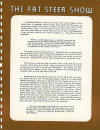 "Something different in the way of a steer show will be staged in Monticello, Iowa, in connection with the Great Jones County Fair this year," announced the Chicago Daily Drovers Journal in regard to the initial Fat Steer Contest held in 1944. It was the first such show seen in this country . . . a steer show based solely on market values and not on show ring technicalities. It was the brain child of H. M. "Stead" Carpenter, Jr., The Drovers Journal continued:
"Something different in the way of a steer show will be staged in Monticello, Iowa, in connection with the Great Jones County Fair this year," announced the Chicago Daily Drovers Journal in regard to the initial Fat Steer Contest held in 1944. It was the first such show seen in this country . . . a steer show based solely on market values and not on show ring technicalities. It was the brain child of H. M. "Stead" Carpenter, Jr., The Drovers Journal continued:
"There is a certain appeal about itbeef that is real beef, not overgrown veal, to be judged, presumably, on yield and valueand a fig for fancy points. It will be an exhibit worth going precious extra miles to see and may easily prove to have significance from the standpoint of future shows of fat steers."
The prophecy has more than come true. Carpenter's show not only brought the commercial producer back to Monticello competition, but proved its fascination for a widespread public, as similar shows have since sprung up all over the country. Producers from distant states annually join the competition here.
The first year of the show, fifty two steers were in competition for $1,445 in prizes, with a first prize of $610. Rules specified that all steers were to be at least two years old and weigh over 1200 pounds. The judging was done by packing house buyers, the best judges available of what potentially juicy, succulent steaks and ribs look like on the hoof.
Permanent pens and bleachers were built north of Floral Hall, in a pleasant, shady area, and over two thousand people watched as a 1,360 pound Hereford belonging to Ray Kurt of Cascade took the coveted first prize. The steer brought $28.50 per hundred-weight at the auction following the judging. Competition that first year was, by chance, entirely among producers within a relatively short distance of Monticello - but that kind of competition is said, by Chicago cattlemen, to be among the most rugged in the country. Second money, $366, was awarded an Angus entered by J. F. Mommsen of Miles, a Clinton County entry. Others sharing in the $1,445 prize money of the memorable first Fat Steer Show were Roy Coverdale of Delmar, J. P. Flannagan of Coggon, John P. Kurt and George Kurt of Cascade. A record $4,200 race purse drew much attention to the harness events, as four $800 purses and two $500 purses attracted a fast field from Iowa, Illinois and Minnesota.
"It's by far the biggest thing Monticello and Jones County have ever seen! The 93rd annual Great Jones County Fair is sure to break every record in the books and go down as the "Bestest of the Best"; " . . . boomed the Monticello Express after viewing the 1946 exhibition.
 Perhaps that sort of enthusiasm sounded a bit monotonous after it had been rolling off annually since 1874. But it was always borne out as shows and facilities kept abreast of every-growing crowds and widening interests. To accommodate a larger Midway, and keep up with the demands for space by commercial exhibitors, a level three acre tract known as "Clark's Lots," located just west of the Country Club was purchased by the Fair Association. An option was also taken on the Bajasch property, which consisted of 33 acres east of the race track. This was later purchased and became a parking area and golf course. A large brick rest-room for women was constructed near Floral Hall and a building was erected on the former poultry building foundation as a dormitory for the 4-H boys.
Perhaps that sort of enthusiasm sounded a bit monotonous after it had been rolling off annually since 1874. But it was always borne out as shows and facilities kept abreast of every-growing crowds and widening interests. To accommodate a larger Midway, and keep up with the demands for space by commercial exhibitors, a level three acre tract known as "Clark's Lots," located just west of the Country Club was purchased by the Fair Association. An option was also taken on the Bajasch property, which consisted of 33 acres east of the race track. This was later purchased and became a parking area and golf course. A large brick rest-room for women was constructed near Floral Hall and a building was erected on the former poultry building foundation as a dormitory for the 4-H boys.
The annual Fat Steer Show was growing, too. The 1945 first prize money of $750 had been taken by an Angus shown by Fred and George Schmidt of Delmar. In 1946 first prize money was raised to $1,000 and was taken by Herman Helgens of Monticello.
Entries of 4-H projects were the largest in Eastern Iowa. Free attractions were on the spectacular side, as the WHO Barn Dance and the All-American Thrill Show provided varied entertainment, in addition to the regular free acts.
Some time during 1946, '47 or '48 . . . her name was so obscure and unheralded at the time that no one remembered the exact year . . . a hill billy style singer appeared here in one of the acts. An attractive girl, with talent and personality, she was included in fair movies taken at the time. Her name was, or is now, Jeanette Davis of radio and TV fame and almost as much a household byword, as that of her current employer, Arthur Godfrey.
The Fat Steer Show gained momentum until in 1949 it was ranked in interest and excellence with the Royal, International and Western expositions as one of the nations top four shows. Ray Kurt of Cascade, winner of the first Fat Steer Show had the thrill of being the first two time winner of the event, and became the proud possessor of the $1,000 first prize and a huge trophy. For the first time in its ninety-six years an advance sale of grandstand and reserved seats was held and met with high favor. Reserved parking space on the grounds was also sold.
Enforcement of State Laws gave the 1950 Fair a new look, as gambling devices and games of chance were prohibited. Unprecedented demand for commercial display space more than took up space left by their closing.
Entertainment offered this year included, for the first time, Stock Car Races, which were gaining wide interest. The Fair association had sought to satisfy all tastes and found more than twenty-five thousand people jamming the grounds on Saturday, the last day of the Fair, for the event.
Attendance Wednesday had reached ten thousand . . . a record for opening day, fourteen thousand on Thursday and sixteen thousand on Friday.
Spectators from 20 states watched the Fat Steer Show in 1950. It drew several out-of-state entries, including one from the boys' 4-H club of Pecos County, Texas, members of which made the trip to Monticello in a large semi-trailer converted to sleeping quarters, cooking meals along the roadside as they traveled. Also represented were Kremmeley, Colorado and Boys Town, Nebraska. John C. Neibohr of Dysart won the event with a 1,210 pound Hereford. The entry of Gus Tietgen of Comanche was second.
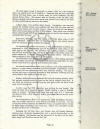 All roads again turned to Monticello in August, 1951, as a new livestock show was added to the list of headliners. Patterned after the now nationally famous Fat Steer Show, was a similar event for swine producers, the first Annual Barrow Show. This contest, held on Thursday in the Fat Steer pens, likewise ignored usual fancy show points, and awards were made on the basis of what would bring top money on the market.
All roads again turned to Monticello in August, 1951, as a new livestock show was added to the list of headliners. Patterned after the now nationally famous Fat Steer Show, was a similar event for swine producers, the first Annual Barrow Show. This contest, held on Thursday in the Fat Steer pens, likewise ignored usual fancy show points, and awards were made on the basis of what would bring top money on the market.
Judges again were packing house buyers. Competition was top-notch among the hundred entries, and exhibitors felt that both the show and the liberal prize money were of much interest. Honor of wining the first Barrow Show went to Louis Ruess and Sons of West Liberty. Their winner was a Poland China which brought $49.50 per hundred weight as the first ten winners were auctioned after the show.
Boys Town, Nebraska took first money in the Steer Show with a 1,175 pound Hereford. William T. Weir of Gladstone, Illinois, won second money. Over five thousand people watched the judging.
To centralize fair offices and services, a new administration building was constructed in 1951, incorporating part of the old brick ticket office at the main gate of the grounds. The attractive, new building includes a modern first aid and hospital unit, lost and found department, information center and public telephones, as well as administrative and ticket offices. The Fair secretary maintains a year round office in this building.
The 99th Great Jones County Fair rolled around in 1952, feeling somewhat like the preface and preview to the gala 1953 Centennial celebration, for even further improvements in grounds and facilities were made.
An extensive earth filling project was carried out, north of the amphitheatre, filling in a large hollow which had prevented overflow amphitheatre crowds from seeing the free attractions, unless they remained standing. The size of the free acts stage was greatly increased so that spectators watching from the newly filled-in area could see all of the acts.
Modern drinking fountains replaced the iron and concrete fountain which had sprayed passing crowds for years on the site of original Floral Hall. A new black top street was surfaced from the main gate to the 4-H barns at the north end of the grounds.
In other ways the 1952 exposition was winning its own laurels. The Ninth Fat Steer Show awarded another $3,450, making a total of $28,095 given its winners. Thousand dollar prize that year went to J. F. Mommsen and Sons of Miles, whose Aberdeen Angus was judged best of seventy seven other entries.
The Annual Barrow Show in its second year under Ed Helgen's chairmanship, was smaller because of swine disease prevailing in the state. But out of sixty five entries competing for $200 first money, a crossbreed barrow owned by Ralph Keppy of Eldridge came away top. Second was a Berkshire owned by Bob and Ray Faint of Havelock.
Sweeping the 4-H beef show was thirteen year old Gordon Eberhart, claiming three divisional championships and a grand championship at the close of judging. His Hereford was top baby beef in the show and his Aberdeen Angus and Shorthorn earned first, too.
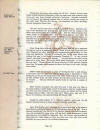 Outstanding attractions also marked the '52 Fair. Western Frontier Days Rodeo thrilled audiences Wednesday, while the largest and most elaborate stage revue ever seen here attracted enthusiastic thousands. Featured entertainer was the famous Joe Howard, beloved star of musical comedy and emcee of the radio show CBS Gay 90's Review. He headlined the Boyle Woolfolk's Summer Sensations Revue, here.
Outstanding attractions also marked the '52 Fair. Western Frontier Days Rodeo thrilled audiences Wednesday, while the largest and most elaborate stage revue ever seen here attracted enthusiastic thousands. Featured entertainer was the famous Joe Howard, beloved star of musical comedy and emcee of the radio show CBS Gay 90's Review. He headlined the Boyle Woolfolk's Summer Sensations Revue, here.
"But just wait for next year," everything seemed to say. Certainly nothing on the Monticello fair grounds had yet ranked with the ending of the Great Jones County Fair's first hundred years. And the 1953 Centennial Fair seems worthy of all expectations. Ever improving facilities, now make the grounds one of the best in the nation for holding fairs. The Fair enjoys undisputed rank of second place among the county fairs of the nation. (Another Iowa Fair, the famous Spencer Exposition, is first. It is generally considered tri-county, however.)
Many things have combined to give the hundred year old Fair a continued heritage as well as a progressive future. Nobel Winner and Candy Bill have since departed, but other showmen and concessionaires are bidding for their fame and familiarity. Starting its fourteenth year on the Jones County Fair midway this year is the Sunset Amusement Company . . . "a very unusual record," according to owner K. H. Garmen . . . "unusual because the field usually plays out in a few years. But not the Great Jones County Fair. It's one of the best we work." Garmen formed his Sunset company in 1929 and now employs more than 185 people and transports his show and rides via 45 trucks, through seven states.
Oldest single concessionaire in years of 'making the fair' is Jack Lindsay, a tall Texas who first appeared with his Bingo stand in Monticello in 1919. Though his son has run the stand here in late years, while Lindsay Sr. takes care of more southern dates, the older Lindsay says the Great Jones County Fair is his favorite . . . "because Monticello people made me feel like a resident of the town."
Other familiar concession men seen here year in and year out, often in the same location, include: Ralph Jewett of Davenport, who has vended carmel corn from the same location for twenty-two years; Joe Ristick and his family of Gypsy fortune tellers, who first came here fifteen years ago; and C. R. Farmer of Anamosa, who replaced Candy Bill around 1930.
Though he died recently, D. V. Morgan's popcorn stand near the old fountain became familiar to many during his eighteen years here.
Many local people, some belonging to the past, and some to the present, have likewise contributed loyally to the continuing success of the Fair. One to long be remembered is the late Dr. A. M. Maurice, veteran Monticello horseman, who was connected for many years with the Fair's speed department in both administrative and competitive capacities. Mrs. Ida Iverson, superintendent of Floral Hall, Mrs. Mike Hogan and Mrs. Ava Main are a few who have served faithfully for many years in the exhibitors department.
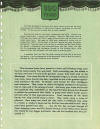 The 1953 Hundredth Anniversary Fair seems worlds away from the timid, unpromising little collection of agricultural products comprising the first Fair of 1853. Yet the two are far closer than is readily realized.
The 1953 Hundredth Anniversary Fair seems worlds away from the timid, unpromising little collection of agricultural products comprising the first Fair of 1853. Yet the two are far closer than is readily realized.
Grounds and facilities have been transformed since 1874. Livestock has gained unbelievably in quality and quantity. Peavine's 1866 track mark of 2:52 looks dim beside the 2:06 of pacer Jimmy Bumpus and the 2:08 of the trotter Jackie Davis. Fair goers of 1853 never dreamed of crowds and attractions like 1953's. But the spirit of the Fair remains the same throughout the Century. The pride taken by Jones County residents and the Jones County Fair Board, in themselves, their accomplishments, and their county, has kept the Fair progressing and developing though its first hundred years, while dozens of other fairs collapsed with hard times, or growing pains.
A quotation from the 1904 Fair book, starting the last half of the Fair's first century, is just as appropriate at the spectacular finale of that first century, changing the fifty year reference to one hundred:
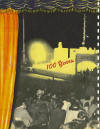 "One hundred years have passed on time's swift fleeting wings since the first Jones County Fair was held. Each succeeding year has added to its fame until now it is one of the greatest county fairs held west of the Mississippi. Ever since the tide of immigration began to sweep westward over Iowa, Jones County has been regarded as one of the greatest agricultural counties in the state. Its citizens were famed for their intelligence and enterprise. They strove to attain the highest standard in the production of crops and in the raising of stock. And every year when the harvest was gathered they assembled on the beautiful Jones County Fair Grounds to exhibit the products of their fields, to grasp each other's hands and to tell each other of their joys and sorrows. Fond memories of the Jones County Fair cling around many a heart. They recall many a scene of pleasure. How many can recall the time when in childhood they clung to a father or mother's hand and for the first time attended the Fair. Many years have passed since then . . . but the Fair has survived through all these changing years and the Second Century of the Great Jones County Fair should be even bigger and better than the first hundred fairs that preceeded it."
"One hundred years have passed on time's swift fleeting wings since the first Jones County Fair was held. Each succeeding year has added to its fame until now it is one of the greatest county fairs held west of the Mississippi. Ever since the tide of immigration began to sweep westward over Iowa, Jones County has been regarded as one of the greatest agricultural counties in the state. Its citizens were famed for their intelligence and enterprise. They strove to attain the highest standard in the production of crops and in the raising of stock. And every year when the harvest was gathered they assembled on the beautiful Jones County Fair Grounds to exhibit the products of their fields, to grasp each other's hands and to tell each other of their joys and sorrows. Fond memories of the Jones County Fair cling around many a heart. They recall many a scene of pleasure. How many can recall the time when in childhood they clung to a father or mother's hand and for the first time attended the Fair. Many years have passed since then . . . but the Fair has survived through all these changing years and the Second Century of the Great Jones County Fair should be even bigger and better than the first hundred fairs that preceeded it."
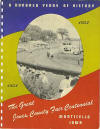 The Great Jones County Fair Centennial:
The Great Jones County Fair Centennial:














